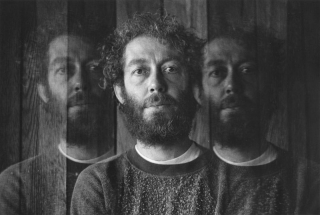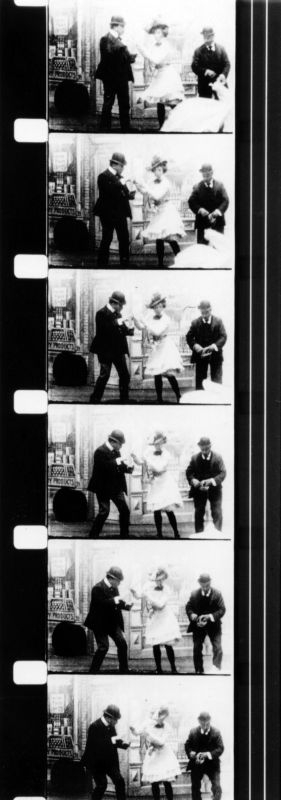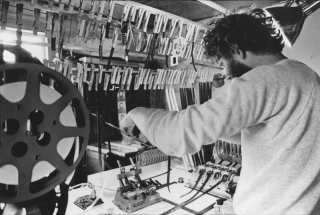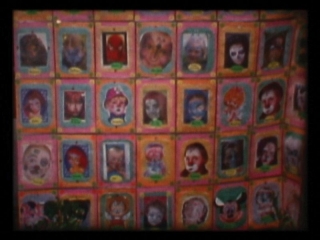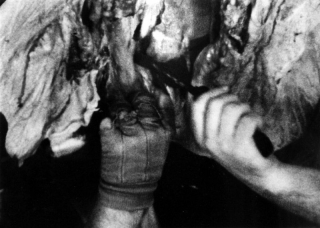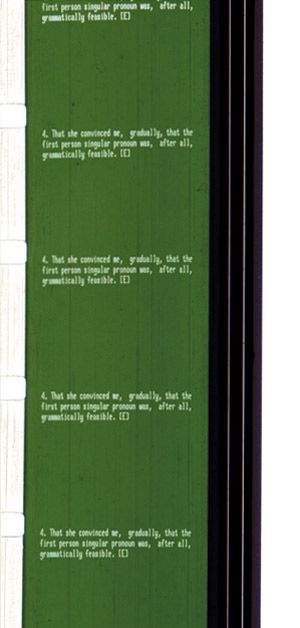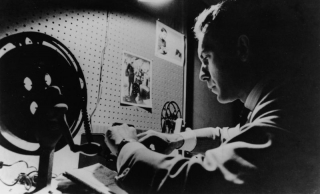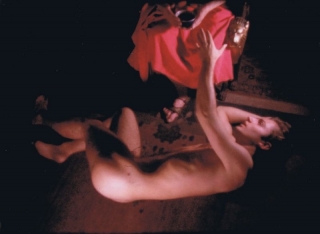Date: 11 November 2007 | Season: Hollis Frampton Magellan | Tags: Hollis Frampton, Magellan
HOLLIS FRAMPTON’S “MAGELLAN”
11—18 November 2007
London National Maritime Museum
A screening, over two consecutive Sundays, of Hollis Frampton’s monumental film sequence Magellan, which uses Fernand Magellan’s circumnavigatory voyage as a metaphor for a meditation on the history and language of cinema, and the phenomena of perception.
“A series of shaped observations that include portraits, cadaver footage, re-stagings of Lumière films, visits to slaughterhouses, double exposures, a field of peaceful dairy cattle, allusions to Muybridge, electronic imagery, industrial pictures, a state fair – a kind of capsule version of the twentieth century that might have been placed on the Voyager spacecraft as it soared out of the solar system to worlds unknown.” —Robert Haller, Anthology Film Archives
In composing his metahistory of cinema, Frampton often refers to other films and filmic modes, quotes liberally from early cinema (specifically the paper print collection of the Library of Congress) and explores countless possibilities for montage and the relationship between sound and image.
Originally intended as a 36-hour sequence in which individual titles would be shown on specific days in a calendar of one year and four days, it was left unfinished when Frampton died in 1984. The surviving 8 hours of material, comprising of almost 30 individual films, will be screened together for the first time in the UK.
The schedule of four two-hour programmes, as structured by Michael Zryd and comprising of almost 30 individual films, is based on the artist’s 1978 “Magellan Calendar” and his last work-in-progress screenings at the Whitney Museum of American Art (New York) in January 1980. It was first shown in this form at Anthology Film Archives (New York) in September 2003.
Sunday 11 November 2007
12pm – 2pm The Birth of Magellan (introduced by Michael Zryd)
3pm – 5pm The Straits of Magellan I
Sunday 18 November 2007
12pm – 2pm The Straits of Magellan II
3pm – 5pm The Death of Magellan
Hollis Frampton, one of the key filmmakers of his generation, was also a noted photographer and theorist, whose remarkable writing was published frequently in Artforum and October.
“Frampton is generally understood, in his words, as an artist ‘of the modernist persuasion,’ not only for his aesthetics, but for his close personal association with such figures as Ezra Pound, Carl Andre, Frank Stella, and Stan Brakhage. Certainly, Frampton conceived of Magellan as a utopian artwork in the monumental tradition of James Joyce and Sergei Eisenstein. In a grant application, he hoped to realize the project as ‘the notion of an hypothetically totally inclusive work of film art as epistemological model for the conscious human universe’.”
(Michael Zryd, York University, Toronto)
The event at the National Maritime Museum is curated by Mark Webber. With thanks to Michael Zryd, Marion Faller, Wendy Dorsett, Lisa Le Feuvre, Helen Whiteoak, Benjamin Cook, M.M. Serra, Anthology Film Archives and The Film-Makers’ Cooperative. Presented in association with LUX.
Hollis Frampton’s book “Circles of Confusion”, which has been out-of-print for many years, has been published in an expanded edition by MIT Press.
Portrait of Hollis Frampton (directed by H.F.) by Marion Faller. Courtesy Anthology Film Archives. © 1975 Estate of Hollis Frampton.
PROGRAMME NOTES
HOLLIS FRAMPTON’S “MAGELLAN”
Sunday 11 & Sunday 18 November 2007
London National Maritime Museum
“In the beginning of time, light drew out matter along itself into a mass as great as the fabric of the world.” (11th century Latin text by Robert Grossteste, translated by Hollis Frampton)
Hollis Frampton (1936-84) is acknowledged as a giant in American avant-garde cinema, but tends to be known mainly through two (admittedly fantastic) films, Zorns Lemma (1970) Hapax Legomena I: (nostalgia) (1971). Meanwhile, his most ambitious and complex film project, Magellan, is generally less recognized.
The omission is unfortunate. Keeping in mind that most of Frampton’s remarkable writings (collected in the book Circles of Confusion, 1983) were written during the Magellan period, and that Frampton was engaged in many tantalizing and prophetic projects, including computer design and video, at the time of his premature death of lung cancer, we lose much in ignoring the last 12 years of Frampton’s work. The invisibility of Magellan is also understandable.
The contemporary spectator who approaches the unfinished Magellan confronts only fragments; the 24 completed Magellan films released by Frampton comprise only about 8 out of the 36 hours planned. Moreover, Frampton intended Magellan to be a calendrical cycle, with specific films to be shown on each day of the year. Metaphorically modelled on Ferdinand Magellan’s exploratory circumnavigation of the world, the film aspired to remarkable ‘global’ aesthetic, historiographic, and conceptual challenges to cinema and perception.
Frampton is generally understood, in his words, as an artist “of the modernist persuasion,” not only for his aesthetics, but for his close personal association with such figures as Ezra Pound, Carl Andre, Frank Stella, and Stan Brakhage. Certainly, Frampton conceived of Magellan as a utopian artwork in the monumental tradition of James Joyce and Sergei Eisenstein. In a grant application, he hoped to realize the project as “the notion of an hypothetically totally inclusive work of film art as epistemological model for the conscious human universe.”
The enterprise did not lack ambition. But Frampton was always ambivalent towards the Enlightenment project that drove hardcore Modernism. His playful and ironic sensibility, nurtured through his association with artists like Michael Snow, Twyla Tharp, and Joyce Wieland is distilled in his announcement that Magellan was ultimately a comedy – insofar as “comic art resolves itself in favour of its protagonist.” For Frampton, “the protagonist is the spectator of the work.”
Comparing Magellan to Vadimir Tatlin’s unrealized Monument to the Third International, Frampton said: “The Monument was not built. There are other ways to build monuments. The ways to build them are to build them immaterially, in the mind.” Fittingly then, Magellan is an edifice whose very incompletion invites us to participate and continue its infinite construction.
—Michael Zryd, York University, Toronto
Back to top
Date: 11 November 2007 | Season: Hollis Frampton Magellan | Tags: Hollis Frampton, Magellan
THE BIRTH OF MAGELLAN
Sunday 11 November 2007, at 12pm
London National Maritime Museum
CADENZA I AND XIV
Hollis Frampton, USA, 1977-80, 16mm, colour, sound, 11 min
A prelude to Magellan’s universe, rife with allusions to Creation and Duchampian sexual puns: “The film about the bride in which two gentlemen, who we may presume to be bachelors, strip more or less bare a putative bride of some sort.” (HF)
MINDFALL I
Hollis Frampton, USA, 1977-80, 16mm, colour, sound, 10 min
Emerges out of HF’s experiments with sound and Eisenstein’s ‘vertical montage’: “If you start responding to every stimulus, then you end up as a nerve gas case, quite literally. All the neurons fire at once.” (HF)
MATRIX [FIRST DREAM]
Hollis Frampton, USA, 1977-79, 16mm, colour, silent, 28 min
A film of multiple superimpositions, utilizing the images of SOLARIUMAGELANI (a film shown later in the cycle) and the hexagonal images that recur throughout Magellan.
PALINDROME [SECOND DREAM]
Hollis Frampton, USA, 1969, 16mm, colour, silent, 22 min
An early film of HF’s which was later incorporated into Magellan: “The menacing Latin palindrome IN GIRVM IMVS NOCTE ET CONSVMIMVR IGNI (By night we go (down) into a gyre / and we are burned in fire) serves as an epigraph to this animated film.” (HF)
MINDFALL VII
Hollis Frampton, USA, 1977-80, 16mm, colour, sound, 10 min
See above
NOCTILUCA [MAGELLAN’S TOYS #1]
Hollis Frampton, USA, 1974, 16mm, colour, silent, 4 min
“Designed to be shown on the second day of the Magellan cycle. The title (nox / luceo) means something that shines at night, i.e. the moon […] The second day of the cycle seems to be an inventory of the knowledge, machines, and arms that Magellan – and latter-day voyagers like HF – had at the outset of his journey.” (Brian Henderson)
Date: 11 November 2007 | Season: Hollis Frampton Magellan | Tags: Hollis Frampton, Magellan
THE STRAITS OF MAGELLAN I
Sunday 11 November 2007, at 3pm
London National Maritime Museum
PUBLIC DOMAIN
Hollis Frampton, USA, 1972, 16mm, b/w, silent, 14 min
A found-film composed of early films, arranged alphabetically according to copyright title, all readily retrievable / quotable fragments from our finite federal version of the “infinite film / the paper print collection at the Library of Congress.” (Bruce Jenkins)
STRAITS OF MAGELLAN: DRAFTS AND FRAGMENTS [PANOPTICONS]
Hollis Frampton, USA, 1974, 16mm, colour, silent, 51 min (20 min excerpt)
Directly inspired by the Lumière brother’s actualities, these one-minute films (49 of which are collected in Drafts and Fragments), are arranged around the circumference of the Magellan Calendar. Named Panopticons, they allude to Jeremy Bentham’s famous plan for a prison, and point to the dark ironies of Magellan’s Enlightenment project.
INGEIMM VIBIS IPSA PVELLA FECIT [VERNAL EQUINOX]
Hollis Frampton, USA, 1975, 16mm, colour, silent, 62 min (5 min excerpt)
Inspired by Eadweard Muybridge’s nude motion studies, this film was intended to be shown in 13 parts distributed equally through the calendar year.
SUMMER SOLSTICE [SOLARIUMAGELANI 2]
Hollis Frampton, USA, 1974, 16mm, colour, silent, 32 min
“The operations that dislocate a film like Summer Solstice – I hope irreparably – from being a movie about the locomotion and eating habits of cows, a dairy film document or what have you, are finally of a whole lot less concern to me than the following things: how it looks, the sense that probably it was done deliberately, the pleasure or displeasure – the intrigue possibly – of attempting to retrieve the manner in which it was done while one is watching.” (HF)
STRAITS OF MAGELLAN: DRAFTS AND FRAGMENTS [PANOPTICONS]
Hollis Frampton, USA, 1974, 16mm, colour, silent, 51 min (20 min excerpt)
See above
PAS DE TROIS
Hollis Frampton, USA, 1975, 16mm, colour, silent, 4 min
An analysis of film’s persistent relationship to sexuality, mediated by allusions to early cinema’s flicker and other aggressive qualities of the cinematic apparatus.
INGEIMM VIBIS IPSA PVELLA FECIT [VERNAL EQUINOX]
Hollis Frampton, USA, 1975, 16mm, colour, silent, 62 min (5 min excerpt)
See above
Date: 13 November 2007 | Season: The Wire 25
THE ROAD TO WHO KNOWS WHERE
London Roxy Bar and Screen
Tuesday 13 November 2007, at 8pm
Two fragmented and dysfunctional road movies imagined as a series of episodic vignettes or misty memories. Jessie Stead’s Foggy Mountains Breakdown More Than Non-Foggy Mountains, a cryptic album of weird and wonderful versions of Flatt & Scrugg’s bluegrass standard won first prize at the Ann Arbor Film Festival. The Secret Apocalyptic Love Diaries of Enid Baxter Blader is a windswept folk-poem shot on a homemade video camera. Both cast a discreet nod of recognition to Harry Smith’s Anthology of American Folk Music.
Enid Baxter Blader, Secret Apocalyptic Love Diaries, USA, 2006-07, 12 min
Jesse Stead, Foggy Mountains Breakdown More Than Non-Foggy Mountains, USA, 2006, 59 min
PROGRAMME NOTES
THE ROAD TO WHO KNOWS WHERE
London Roxy Bar and Screen
Tuesday 13 November 2007, at 8pm
THE SECRET APOCALYPTIC LOVE DIARIES
Enid Baxter Blayder, USA, 2006-07, video, b/w, sound, 12 min
“Secret Apocalyptic Love Diaries consists of vignettes that document blinding lightning storms, violent rainfalls, and other radical, dramatic forces of nature, which are interspersed between narrative snippets that capture accidental, unscripted exchanges between friends and couples. From these vulnerable moments an intimate portrait emerges, one that depicts stumbling friendships and romantic relationships that start up and inevitably turn disappointing. The sense of vulnerability is enhanced by the video’s music, which was largely composed and performed by the artist, an accomplished singer, banjo player, and bluegrass musician originally from Appalachia. Sweet and tender, and awed by the ability of others to inspire and astonish, Secret Apocalyptic Love Diaries portends an inevitable, inexorable disappointment even in the most optimistic moments, such as the earliest days of a budding relationship. Its characters are vulnerable to forces of nature, both external or internal; to the affections and whims of others; to a driving rain that extinguishes one’s cigarette; to the unsettling presence of a lover’s former lover. From a howling dog accompanying a blues musician’s plaintive harmonica, to a group of bored friends standing around drinking while playing casually with power tools, to floodwaters pouring over a country road, the quiet melancholy in Secret Apocalyptic Love Diaries is as palpable as dark billows of smoke filling up a big clear sky.” (Irene Tsatsos)
FOGGY MOUNTAINS BREAKDOWN MORE THAN NON-FOGGY MOUNTAINS
Jessie Stead, USA, 2006, video, colour, sound, 59 min
“There are simultaneously many non-personal (structural, social and historical) reasons the bluegrass music instrumental Foggy Mountain Breakdown inspired the motion picture Foggy Mountains Breakdown More Than Non-Foggy Mountains. I cannot deny, however, that a highly distinctive resonance with this piece of music can be traced back to the newly formed eardrums of my own literal infancy. My biological father, having the daily habit of picking bluegrass banjo, accidentally subjected me to this instrumental (among others) as I did my time in the womb. The very fact of this inadvertent exposure, and what I can hazily identify as the primal origins of my personal sonic memory, lead me to confront Foggy Mountain Breakdown as the anachronistic soundtrack for the dawn of my awakening consciousness. In a macro sense, however, as representation of the bluegrass music genre (one identified as native to the USA, relatively speaking) Foggy Mountain Breakdown’s resonance as music will depend heavily on the social landscape it overlays. Its associations today are unquestionably nostalgic and instantly lend themselves to a stereotypically American ‘low-brow’ set of clichéd references; southern, rural, poor, white, etc. (especially within social constructions which identify with realities outside of these). In other words, the question of whether or not it is considered “enjoyable” may rely more on a degree of favour or distrust for the associations it recalls within the ear of the beholder(s), rather than on an evaluation of its formal characteristics. That said, how possible is the distillation of anything? How valuable is it? FMB MT N-FM’s premier flight of fancy is to pose these questions as animals bleached by the sun. These are questions of exposure and relativity … variety and socio-cultural identity … idealism and destination … the foggy mountain and the non-foggy mountain … and finally, the literal and the metaphysical question of where one maps oneself on the ‘world stage’.” (Jessie Stead)
Back to top
Date: 18 November 2007 | Season: Hollis Frampton Magellan | Tags: Hollis Frampton, Magellan
THE STRAITS OF MAGELLAN II
Sunday 18 November 2007, at 12pm
London National Maritime Museum
AUTUMNAL EQUINOX [SOLARIUMAGELANI 3]
Hollis Frampton, USA, 1974, 16mm, colour, silent, 27 min
The cows of Summer Solstice reappear, here filmed in a slaughterhouse, animated by HF’s revelation that animals are as beautiful on the inside as they are on the outside.
WINTER SOLSTICE [SOLARIUMAGELANI 4]
Hollis Frampton, USA, 1974, 16mm, colour, silent, 33 min
Shot in a steel mill, “a pre-textual locus dearly beloved by our Soviet predecessors” (HF), this film’s rhythmic and compositional textures pay tribute not only to Eisenstein and Vertov, but also to Abstract Expressionists like Franz Kline, Mark Rothko, and Clyfford Still.
STRAITS OF MAGELLAN: DRAFTS AND FRAGMENTS [PANOPTICONS]
Hollis Frampton, USA, 1974, 16mm, silent, 51 min (4 min excerpt)
“A sampling of 49 fragments from Frampton’s catalogue of ‘actualities,’ the films from Straits Of Magellan: Drafts & Fragments are all silent and unedited. Several invoke directly the work of the Lumières, as in Frampton’s reworking of Démolition d’un mur (1895), in which a dilapidated farm silo is demolished in place of the Lumières’ wall. He makes reference to his own work … and pays homage to the work of contemporaries. A complex range of formal issues are raised in other fragments. Finally, Frampton offers a number of analogues for the act of filming and cinematic seeing that include a series of appropriated ‘lenses’ (a stone portal, a wooden silo) and a set of ‘screens’ (a pool of water, curtains, a dusty window).” (Bruce Jenkins)
THE RED GATE [MAGELLAN AT THE GATES OF DEATH: PART I]
Hollis Frampton, USA, 1976, 16mm, colour, silent, 52 min (9 min excerpt)
In The Red Gate and The Green Gate the primary imagery comes from a human anatomy laboratory in tribute to and (in contestation with, Stan Brakhage’s The Act Of Seeing With One’s Own Eyes (1971). The films were to be divided into 24 sections, each section to be projected, right side up and forwards, and upside down and backwards according to the Magellan Calendar.
THE GREEN GATE [MAGELLAN AT THE GATES OF DEATH: PART II]
Hollis Frampton, USA, 1976, 16mm, colour, silent, 53 min (9 min excerpt)
See above
STRAITS OF MAGELLAN: DRAFTS AND FRAGMENTS 1 [PANOPTICONS]
Hollis Frampton, USA, 1974, 16mm, colour, silent, 51 min (1 min excerpt)
See above
THE RED GATE [MAGELLAN AT THE GATES OF DEATH: PART I]
Hollis Frampton, USA, 1976, 16mm, colour, silent, 52 min (9 min excerpt)
See above
THE GREEN GATE [MAGELLAN AT THE GATES OF DEATH: PART II]
Hollis Frampton, USA, 1976, 16mm, colour, silent, 53 min (9 min excerpt)
See above
STRAITS OF MAGELLAN: DRAFTS AND FRAGMENTS 1 [PANOPTICONS]
Hollis Frampton, USA, 1974, 16mm, colour, silent, 51 min (4 min excerpt)
See above
Date: 18 November 2007 | Season: Hollis Frampton Magellan | Tags: Hollis Frampton, Magellan
THE DEATH OF MAGELLAN
Sunday 18 November 2007, at 3pm
London National Maritime Museum
APPARATUS SUM [STUDIES FOR MAGELLAN: #1]
Hollis Frampton, USA, 1972, 16mm, colour, silent, 3 min
“A brief lyric film of death, which brings to equilibrium a single reactive image from a room of cadavers.” (HF)
OTHERWISE UNEXPLAINED FIRES [MEMORANDA MAGELANI]
Hollis Frampton, USA, 1976, 16mm, colour, silent, 14 min
“Filmed in large part during HF’s lecture-screening tour of the [San Francisco] Bay area: Visits to the Musée Méchanique, Land’s End, the Cliff House […] A visit to the Brakhage Colorado residence provided images of chickens / roosters.” (Gail Camhi)
QUATERNION [PARES MAGELANI]
Hollis Frampton, USA, 1976, 16mm, colour, silent, 4 min
A visual dialogue with the artist James Rosenquist: “A safari by Hollis into the categorical domains of artifactual debris.” (Patrick Clancy)
YELLOW SPRINGS [MAGELLAN: VANISHING POINT #1, PARES MAGELANI]
Hollis Frampton, USA, 1972, 16mm, colour, silent, 5 min
“A portrait of the filmmaker Paul Sharits, in particular response to energies he generated one May afternoon in 1971.” (HF)
FOR GEORGIA O’KEEFE [PARES MAGELANI]
Hollis Frampton, USA, 1976, 16mm, colour, silent, 4 min
An exquisite homage to O’Keefe’s “Radiator Building, Night.”
MORE THAN MEETS THE EYE [TEMPORA MAGELANI]
Hollis Frampton, USA, 1976, 16mm, colour, silent, 5 min
HF’s affinity with Duchamp informs this film: If Eisenstein remade Anemic Cinema (1926), this film might have been the result.
NOT THE FIRST TIME [TEMPERA MAGELANI]
Hollis Frampton, USA, 1976, 16mm, colour, silent, 5 min
“The viewer is engaged in a process of double vision that returns him to the image and subject in a manner more complex, more self-aware, and more temporal than the way most of us view photographs.” (Fred Camper)
TIGER BALM [MEMORANDA MAGELANI #1, MENS MAGELANI]
Hollis Frampton, USA, 1972, 16mm, colour, silent, 10 min
After two years of massive didacticism in black-and-white [Hapax Legomena, 1971-72)], I am surprised by Tiger Balm, lyrical, in colour, a celebration of generative humours and principles, in homage to the green of England, the light of my dooryard … and consecutive matters.” (HF)
PROCESSION
Hollis Frampton, USA, 1976, 16mm, colour, silent, 4 min
inc. BANNER, USA, 1974, 16mm, colour, silent, 40 sec / DRUM, USA, 1975, 16mm, colour, silent, 20 sec / TUBA, USA, 1976, 16mm, colour, silent, 3 min
A collection of three short films: “A trip to the New York State Fair filtered through a most rarefied formal film.” (Scott MacDonald)
GLORIA!
Hollis Frampton, USA, 1979, 16mm, colour, sound, 10 min
The last film of HF’s oeuvre and the last completed for Magellan, this film encapsulates the meta-history of cinema, bridging early cinema and video, and distils Magellan’s themes: the tension between image and language, Frampton’s ‘sentimental science’, tradition and memory, and the persistence of death.
Date: 20 November 2007 | Season: The Wire 25
EXTRAORDINARY LIVES
London Roxy Bar and Screen
Tuesday 20 November 2007, at 8pm
Luke Fowler’s Bogman Palmjaguar is a portrait of its namesake, a former patient of radical psychologist R.D. Laing who now lives a hermetic life in the Flow Country of the Scottish Highlands. Documenting the environment of the surrounding landscape as much as its human focus, the images are accompanied by Lee Patterson’s evocative field recordings. Genesis P-Orridge and Lady Jaye are the subjects of Marie Losier’s diary/documentary, which pursues the pandrongynous partners at home, visiting MoMA’s Dada exhibition, and on tour with Thee Majesty and Throbbing Gristle.
Luke Fowler, Bogman Palmjaguar, UK, 2007, 30 min
Marie Losier, A Ballad with Genesis P-Orridge and Lady Jaye, France-USA, 2007, 37 min
PROGRAMME NOTES
EXTRAORDINARY LIVES
London Roxy Bar and Screen
Tuesday 20 November 2007, at 8pm
BOGMAN PALMJAGUAR
Luke Fowler, UK, 2007, video, colour, sound, 30 min
“Bogman Palmjaguar is a portrait of a man who after a series of disturbing events became distrustful of people and withdrew into nature. Bogman describes himself as ‘the hidden cat’ and ‘wild outlaw of paradise’ and is fighting against a diagnosis that that brands him as a ‘paranoid schizophrenic’. Bogman’s early life, and the diagnosis, subsequently conditioned his relationships with others, both within and beyond the medical establishment. The decision to take legal action to remove this label is of paramount importance to him, both as a search for justice and to seek reason in the course his life has taken over the past three decades. The film was shot across two visits to Bogman’s home in a remote village in the north of Scotland. The former was motivated by Bogman’s solicitor’s request of an independent report by Dr. Leon Redler (author and college of R. D. Laing), to assess whether the label ‘paranoid schizophrenic’ was justified. The latter was in collaboration with sound artist Lee Patterson, documenting the environment which Bogman sought to preserve during his time as a conservationist. Bogman had been passionate about the threatened habitat of Scotland’s Flow Country; a wilderness made of blanket bogs and peatlands that houses a unique diversity of wildlife. However the peatlands also became a hide-out, when Bogman fled attempts to section him. The film is a reconciliation of the young conservationist with his older self; isolated and withdrawn from society.” (Luke Fowler)
A BALLAD WITH GENESIS P-ORRIDGE AND LADY JAYE
Marie Losier, USA, 2007, video, colour, sound, 37 min
“I met Genesis by accidentally treading on her feet. I was at an opening in Soho, one of those where you can barely walk and breath and I ended up on her toes. I turned around to apologize and there she was, staring at me smiling with all her golden teeth glittering in my eyes. That’s where it all started. For a while we emailed, learning about each other more and more and one day I ended up in her house, sitting on a giant plastic green chair in the shape of a hand. Since that day I’ve been, in a way, adopted by the family of mom and pop, as Genesis and Lady Jaye call themselves, and by the whole Psychic TV3 band. I’ve been filming them at their home, waking up and going through the routine of being Pandrogynes, which is their main art work today: it’s a living performance in a way. They’ve been having plastic surgery to resemble one another, or rather to be closer to each other in order to break the binary system of male/female, good/bad … creating a third identity that is free from the rules of society. It’s been now a year since I started shooting: they took me on tour in Europe with them, to film them on the routine of the tour. My camera and myself have been totally invited to their life at the rehearsals with the whole band, at home with their favourite person, their dog, Big Boy, with friends, their daughters, going through their incredibly busy daily lifestyles between recording albums, preparing concerts, being in three bands, making art pieces for gallery shows, writing books, doing a raw food diet, shopping for mini skirts, cleaning, and growing their garden in their Bushwick house … there is a lot more I need to capture, but what you will see now is a sort of love ballad for them.” (Marie Losier)
Back to top
Date: 7 March 2008 | Season: Gregory Markopoulos 2008 | Tags: Gregory Markopoulos, Markopoulos
GREGORY J. MARKOPOULOS
7—8 March 2008
London Tate Modern
Gregory J. Markopoulos (1928–1992) was a key figure in the evolution of the New American Cinema of the 1960s, an archetypal personal filmmaker who counted Jack Smith, Kenneth Anger, Stan Brakhage and Maya Deren amongst his contemporaries. His ravishing films are a complex combination of masterful camerawork and editing with a strong vision rooted in myth and poetry.
As his reputation reach its peak, Markopoulos rejected the independent film movement and relocated from New York to Europe in 1967. There, he planned the construction of an archive and projection space – The Temenos – on a remote site in the Greek countryside, a setting that would be in harmony with his extraordinary films.
In his later years, he meticulously edited his life’s work, incorporating over 100 individual titles, into an 80-hour long silent film for presentation only at his chosen location in Arcadia. Since Markopoulos’ death in 1992, the filmmaker Robert Beavers (himself the subject of a Tate Modern retrospective in February 2007) has been working towards the final printing and exhibition of this unique work. The screenings of the first two sections (“orders”) of ENIAIOS took place in 2004 and were commemorated in articles in Artforum, Frieze and Film Comment.
PORTRAITS OF ARTISTS: Friday 7 March 2008
THE ILLIAC PASSION: Saturday 8 March 2008
This rare opportunity to view a selection of Markopoulos’ films in London anticipates TEMENOS 2008; the free, open-air premieres of ENIAIOS III-V that will take place close to the village of Lyssaraia on 27-29 June 2008.
The Tate Modern screenings are curated by Stuart Comer and Mark Webber, and will be introduced by Robert Beavers.
Back to top
Date: 7 March 2008 | Season: Gregory Markopoulos 2008 | Tags: Gregory Markopoulos, Markopoulos
MARKOPOULOS: PORTRAITS OF ARTISTS
Friday 7 March 2008, at 7pm
London Tate Modern
Markopoulos made many extraordinary film portraits, which often incorporate an activity or object that has personal significance to the subject. This programme presents a selection of poetic and sensuous portraits of cultural and art world luminaries such as Gilbert & George, Alberto Moravia, Giorgio di Chirico and Rudolph Nureyev.
Gregory J. Markopoulos, Through A Lens Brightly: Mark Turbyfill, USA, 1967, 15 min
Portrait of Mark Turbyfill
Gregory J. Markopoulos, Eniaios (Order III, Reel 1) (Gibraltar), Switzerland, 1975, 15 min
Portrait of Gilbert & George
Gregory J. Markopoulos, Eniaios (Order IV, Reel 6) (The Olympian), Italy, 1969, 23 min
Portrait of Alberto Moravia
Political Portraits (excerpt)
Gregory J. Markopoulos, Europe, 1969, 15 min
Portraits of Ulrich Herzog, Marcia Haydee, Rudolph Nureyev, Giorgio di Chirico
Gregory J. Markopoulos, Eniaios (Order II, Reel 2), Europe, undated, 23 min
Portraits of Hans-Jakob Siber, Franco Quadri, Giorgio Frapoli, Klaus Schönherr and family
“The films preserve the myriad flights of isolated, spectrally splintered and itinerant spirit, lost in yearning, in search of intuitive wholeness while negotiating mazes of desire, seeking sanctuary in the reflection of countless identities. The works hold a shimmering mirror up to the contradictory compulsions of an era, set to register, for a few instants, shocks of recognition.” (Kirk Winslow, Millennium Film Journal)
The screening will be introduced by Robert Beavers.
Back to top
Date: 8 March 2008 | Season: Gregory Markopoulos 2008 | Tags: Gregory Markopoulos, Markopoulos
MARKOPOULOS: THE ILLIAC PASSION
Saturday 8 March 2008, at 7pm
London Tate Modern
Throughout his life, Markopoulos remained closely connected to his heritage and ultimately saw the Greek landscape as the ideal setting for viewing his films. THE ILLIAC PASSION, one of his most highly acclaimed films, is a visionary interpretation of ‘Prometheus Bound’ starring mythical beings from the 1960s underground. The soundtrack of this contemporary re-imagining of the classical realm features a reading of Thoreau’s translation of the Aeschylus text and excerpts from Bartok.
Gregory J. Markopoulos, The Illiac Passion, USA, 1967, 92 min
“The Illiac Passion, which features chiaroscuro passages reminiscent of Anger’s Inauguration of the Pleasure Dome of 1954, and incorporates 25 characters, is loosely based on Aeschylus’ ‘Prometheus Bound’. For a viewer seeing this extravagant ode to creation some thirty years after its making, the film’s most plangent moments involve Markopoulos’ affectionate casting of friends as mythical figures – Andy Warhol’s Poseidon pumping on an Exercycle above a sea of plastic, Taylor Mead’s Demon leaping, grimacing, and streaming vermilion fringes, and Jack Smith’s bohemian Orpheus, spending a quiet afternoon at home with Eurydice.” (Kristin M. Jones, Artforum)
The screening will be introduced by Robert Beavers.
Back to top
